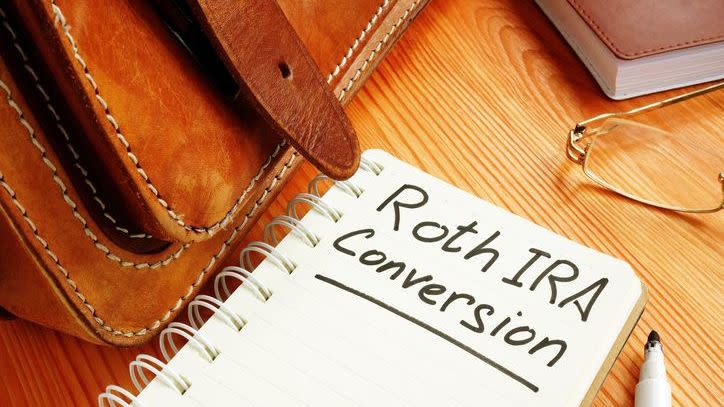SmartAsset and Yahoo Finance LLC may earn commission or revenue through links in the content below.
People with Roth IRAs generally have to wait five years before withdrawing earnings from their account.
But the devil is in the details, and for this particular rule, getting those details can be surprisingly difficult. For starters, the IRS has three different five-year rules that apply to Roth IRAs. One of them, the conversion rule, appears self-contradictory. The IRS doesn’t publish clear instructions on these rules. And each outlet writing about this subject appears to give slightly different information.
In other words, don’t blame yourself if you’re confused. This one is very confusing, which is why working with a financial advisor who understands the ins and outs of the IRS rules can be so helpful. Connect with a fiduciary advisor today.
For example, say you’re 70 years old and your required minimum distributions (RMDs) will start in three years. You’d like to avoid RMDs by converting your $900,000 pre-tax savings into a Roth IRA. How will the five-year rule apply?
The Three Five-Year Rules

Remember, the five-year conversion rule applies to money that you transfer from a pre-tax account into a Roth IRA.
To recap, you must wait at least five years from when you converted the funds before taking a qualified distribution from those assets. This rule applies separately to each conversion. In practice, each time you convert assets into a Roth IRA you must treat that conversion as its own segment of assets, which must remain in place for five years.
However, the conversion rule does not apply if you’re 59 ½ and older. In that case you may take qualified distributions at any time and avoid the 10% early withdrawal penalty.
This is the rule that applies to our hypothetical example from above: you’re 70 years old and have RMDs starting soon. You would like to convert your $900,000 pre-tax portfolio to a Roth IRA to avoid RMDs. If you find yourself in a similar situation and need help planning your Roth conversions, consider speaking with a financial advisor.
Here are two conversion options and how the five-year rule would come into play:
Lump-Sum Conversion at Age 70+
In this case, you convert all $900,000 in one lump sum. This would trigger about $288,000 in federal taxes, leaving you with about $612,000 in your Roth IRA.
You would be free to begin taking qualified distributions from this portfolio immediately. Even though it has been less than five years, you are older than 59 ½ so the conversion rule does not apply.
Staggered Conversions Starting at Age 70
In this case, you might convert $300,000 per year. This would potentially allow you to avoid RMDs, while also reducing your taxes. You could end up paying about $72,000 per year, or $216,000 in total federal taxes on this conversion.
You would be free to begin taking qualified distributions from this portfolio and its earnings immediately. Even though it has been less than five years, again you are older than 59 ½ so the conversion rule does not apply.
Bottom Line
If you plan to execute a Roth conversion to avoid RMDs, you’ll have to understand how the various five-year rules work. One of those rules is specifically related to Roth conversions, dictating that you must wait five years before being eligible to withdraw converted funds tax- and penalty-free. Fortunately, if you’re 59 ½ or older, this five-year rule doesn’t apply.
Tips On Managing Your RMDs
-
Before making any decisions around your required minimum distributions, first you should calculate what they are. To help you do that, SmartAsset built an RMD calculator that will estimate how much your first mandatory withdrawal will be and when it’s due.
-
A financial advisor can help you build a comprehensive retirement plan that takes your RMDs into account. Finding a financial advisor doesn’t have to be hard. SmartAsset’s free tool matches you with up to three vetted financial advisors who serve your area, and you can have a free introductory call with your advisor matches to decide which one you feel is right for you. If you’re ready to find an advisor who can help you achieve your financial goals, get started now.
-
Keep an emergency fund on hand in case you run into unexpected expenses. An emergency fund should be liquid — in an account that isn’t at risk of significant fluctuation like the stock market. The tradeoff is that the value of liquid cash can be eroded by inflation. But a high-interest account allows you to earn compound interest. Compare savings accounts from these banks.
-
Are you a financial advisor looking to grow your business? SmartAsset AMP helps advisors connect with leads and offers marketing automation solutions so you can spend more time making conversions. Learn more about SmartAsset AMP.
Photo credit: ©iStock.com/brizmaker, ©iStock.com/designer491, ©iStock.com/SDI Productions
The post My RMDs Start Soon So I Want to Convert $900k to a Roth, but I’m Getting Conflicting Info About Having to Wait 5 Years to Use the Money appeared first on SmartReads by SmartAsset.


